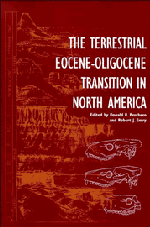Book contents
- Frontmatter
- Contents
- Contributors
- Preface
- PART I The Chronostratigraphy of the Uintan through Arikareean
- 1 Magnetic stratigraphy and biostratigraphy of the middle Eocene Uinta Formation, Uinta Basin, Utah
- 2 Biostratigraphy and magnetostratigraphy of the Bridgerian-Uintan Washakie Formation, Washakie Basin, Wyoming
- 3 Magnetic stratigraphy, sedimentology, and mammalian faunas of the early Uintan Washakie Formation, Sand Wash Basin, northwestern Colorado
- 4 Theoretical biochronology, the Bridgerian-Uintan boundary and the “Shoshonian Subage” of the Uintan
- 5 Middle Eocene mammalian faunas of San Diego County, California
- 6 Stratigraphy and paleomagnetism of the middle Eocene Friars Formation and Poway Group, southwestern San Diego County, California
- 7 Magnetostratigraphy of the upper middle Eocene Coldwater Sandstone, central Ventura County, California
- 8 Stratigraphy and paleomagnetism of the upper middle Eocene to lower Miocene (Uintan to Arikareean) Sespe Formation, Ventura County, California
- 9 Magnetostratigraphy of the Eocene-Oligocene transition in Trans-Pecos Texas
- 10 Magnetic stratigraphy of the Duchesnean part of the Galisteo Formation, New Mexico
- 11 Stratigraphy and vertebrate faunas of the Bridgerian-Duchesnean Clarno Formation, north-central Oregon
- 12 Eocene-Oligocene faunas of the Cypress Hills Formation, Saskatchewan
- 13 Magnetic stratigraphy of the White River Group in the High Plains
- 14 Magnetostratigraphy and biostratigraphy of the Eocene-Oligocene transition, southwestern Montana
- 15 The Whitneyan-Arikareean transition in the High Plains
- PART II Common Vertebrates of the White River Chronofauna
- Summary
- Index
8 - Stratigraphy and paleomagnetism of the upper middle Eocene to lower Miocene (Uintan to Arikareean) Sespe Formation, Ventura County, California
Published online by Cambridge University Press: 06 July 2010
- Frontmatter
- Contents
- Contributors
- Preface
- PART I The Chronostratigraphy of the Uintan through Arikareean
- 1 Magnetic stratigraphy and biostratigraphy of the middle Eocene Uinta Formation, Uinta Basin, Utah
- 2 Biostratigraphy and magnetostratigraphy of the Bridgerian-Uintan Washakie Formation, Washakie Basin, Wyoming
- 3 Magnetic stratigraphy, sedimentology, and mammalian faunas of the early Uintan Washakie Formation, Sand Wash Basin, northwestern Colorado
- 4 Theoretical biochronology, the Bridgerian-Uintan boundary and the “Shoshonian Subage” of the Uintan
- 5 Middle Eocene mammalian faunas of San Diego County, California
- 6 Stratigraphy and paleomagnetism of the middle Eocene Friars Formation and Poway Group, southwestern San Diego County, California
- 7 Magnetostratigraphy of the upper middle Eocene Coldwater Sandstone, central Ventura County, California
- 8 Stratigraphy and paleomagnetism of the upper middle Eocene to lower Miocene (Uintan to Arikareean) Sespe Formation, Ventura County, California
- 9 Magnetostratigraphy of the Eocene-Oligocene transition in Trans-Pecos Texas
- 10 Magnetic stratigraphy of the Duchesnean part of the Galisteo Formation, New Mexico
- 11 Stratigraphy and vertebrate faunas of the Bridgerian-Duchesnean Clarno Formation, north-central Oregon
- 12 Eocene-Oligocene faunas of the Cypress Hills Formation, Saskatchewan
- 13 Magnetic stratigraphy of the White River Group in the High Plains
- 14 Magnetostratigraphy and biostratigraphy of the Eocene-Oligocene transition, southwestern Montana
- 15 The Whitneyan-Arikareean transition in the High Plains
- PART II Common Vertebrates of the White River Chronofauna
- Summary
- Index
Summary
ABSTRACT
The paleomagnetism and heavy mineral assemblages of sandstones from the middle and upper members of the Sespe Formation were studied to clarify stratigraphic relations. Magnetostratigraphic data, and an upsection provenance change reflected in heavy mineral suites, indicate a major intraformational unconformity within the upper member of the Sespe Formation. The hiatus represented by this unconformity apparently spans much or all of the late Eocene and early Oligocene (approximately 29.5-36 Ma). In Simi Valley, the late Uintan and Duchesnean (Chrons C19n-C16r, 41.2-36.5 Ma) and the early Arikareean (Chrons C10r-C9r, 28.0-29.5 Ma) are the only intervals represented by strata. These relations indicate that the Sespe Formation was deposited much more rapidly and discontinuously than previously thought. The most prominent unconformity is attributed to a middle Oligocene eustatic sea level drop. The paleomagnetic results support previous interpretations that the western Transverse Ranges province was technically rotated clockwise by ∼90° during the late Cenozoic.
INTRODUCTION
The Sespe Formation is a sequence of terrestrial clastic rocks typically sandwiched between middle Eocene and lower Miocene marine rocks. It consists of braided fluvial, deltaic, and alluvial fan deposits that crop out in several fault-bounded blocks in southwestern California (Fig. 1). The Sespe Formation is also found in the subsurface offshore and crops out locally on Santa Rosa Island south of the Santa Barbara Channel. Thus, its geographic distribution defines a large non-marine basin elongated in an east-west direction.
- Type
- Chapter
- Information
- The Terrestrial Eocene-Oligocene Transition in North America , pp. 171 - 188Publisher: Cambridge University PressPrint publication year: 1996
- 2
- Cited by



